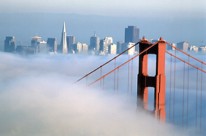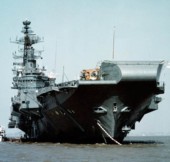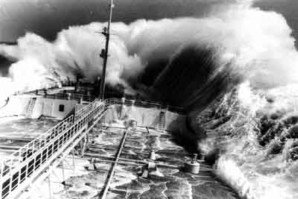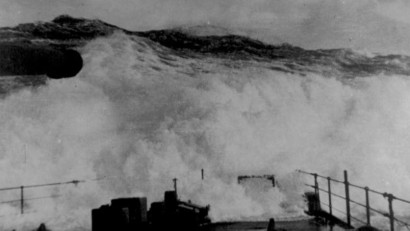
Weather ........ good and bad ! |
FOG ! |


FOGGY MEMORIES FALKENSTIEN: The Motor Ship Magazine was published every month, and was a very well produced glossy source of information on" New buildings" and I had read about the "Schottle Rudder" that the new Hansa (German) heavy lift ship "Falkenstien" had fitted which allowed her to be much more manoeuverable than other vessels. We had run into dense fog off Cape St.Vincent as we headed North and at reduced speed we had been blowing our fog signal every 2 minutes day and night "for ever", or so it seemd, by the time we passed Lisboa.The fog was very thick when we heard another vessel's fog signal. We reduced our speed even further, so that we only had steerage way, when suddenly the lookout rang 2 bells which meant " Vessel close on the port side" Then we saw the Falkenstien very close, almost end on, fine on the port bow. We ordered hard starboard wheel , and she must have done the same and as we started to pass, but our sterns were coming together, so we each ordered port wheel, and we missed each other but had been so close that we could have thrown a heaving line to the other ship.The whole incident took only two minutes at the most, and we were lost to each other again in the fog. THANK GOODNESS FOR HER SPECIAL STEERING GEAR . *************************** FORRESTAL ( Aircraft carrier of the U.S. navy ) We were leaving the Thames in dense dark grey fog, when I noticed what looked like a rectangular patch of paler fog ahead and at about our bridge height "What on earth could that be ?" Then the area ahead seemed to be the same, but darker grey fog. " What causes that ?" "OH ! HECK ! Hard port wheel" It was an American aircraft carrier "beam on" anchored in mid- channel dead ahead blocking our intended course. O.K. so we missed her ( she should not have been anchored there anyway ) and the paler rectangular area of fog which had alerted us to there being something unusual ? As we passed we realised that we had been looking right through the hanger deck at the fog on the far side o the aircraft carrier NOW THAT IS WHAT I CALL " CLOSE" ************************************* AN EXAMPLE OF WHEN FOG WAS NOT FOG We were starting our passage inward near Ushant and had received a weather forecast advising that fog patches were expected. It was midnight when I went on watch and the atmosphere was crystal clear and we had unlimited visibility and could see ships lights from horizon to horizon, then I noticed a small patch of grey mist 4 points on the port bow, isolated fog patch ? ? ? Then we were on to our alteration point and we altered our course to starboard for the next leg, but the whisp of fog kept its bearing even afrer we had settled on the new course, "Strange" and it was getting a little larger. The same thing happened when we next altered our course "Very Strange" The next instant I noticed the mist patch was larger, and closer, It was then that I saw it for what it was................... A LARGE YACHT DISPLAYING NO NAVIGATION LIGHTS
AT ALL AND WHAT I HAD SEEN WAS
THE REFLECTION OF OUR MAINMAST LIGHT
ON HER SAILS ! ! ! What would a large expensive yacht be doing at sea with no lights and getting into close a quarter situation with a loaded tanker. Were the crew all asleep, or maybe they were smugglers ? ********************************** UNKNOWN VESSELS WHICH WERE TOO CLOSE FOR COMFORT IN FOG We were outward bound off the Kent coast and on the starboard side of the channel at reduced speed and blowing our fog signal every 2 minutes with extra lookout on station on the fo'csle head. The radar was on, and we had mulitple echoes all over the place, but no clutter on the screen, so we felt comfortable in the knowledge that there was nothing closing on us that needed action at that moment. Then the lookout rang 3 bells = ship dead ahead and we could see the mast head light of a ship close on the port bow. We rang "stop engines" but knew that we could not alter course to starboard at the moment as there was a multip'le wreck on that side ( a few days previously a coaster had grounded on top of a previous wreck that itself was on top of a war time wreck) The approaching vessel's masthead light vanished from view under our focsle head. I noted the time, and hung on to the bridge dodger, bracing myself for the collision. BUT IT NEVER CAME ! The Captain came up on to the bridge at this time having heard the telegraph and I explained what had happened. We sent a lookout to the fo'csle head so he could speak to the duty lookout to get his report, but he could add nothing to our report, other than "A little ship had got very close under our bow, before shooting off at almost right angles to us, and went off to our port side "all very quickly." Not being able to believe our good luck -at daylight I went forward on some pretext and looked over the side to see if our paintwork had any marks or scratches and none could be found. We believe that the vessel must have been under 150 feet in length hence only one masthead light and she must have been so close under the bow that our bow wave must have helped whatever action she had taken and pushed her clear of our ship. We monitored the radio to check that no vessel / boat had been reported missing or damaged or even radioed in complaints. WE AND THEY HAD BEEN VERY LUCKY. ************************************* KIEL CANAL A very similar incident to the above happened when we had a pilot on board as we left Brunsbuttle Koog in the River Elbe in thick fog.A small coaster came towards us on the wrong side of the channel and her masthead light vanished from view under our bow. The bridge was fully manned for manoeuvering in port having the Captain, Pilot, Apprentice, Helmsman Lookout and myself having just returned from the fo'csle head. The incident was a study in how people react diferently depending on:- ........What they saw ........What their experience allowed them to appreciate ........What was their responsibility in running the ship AGAIN WE WERE LUCKY in that the vessels did not make contact with each other but I reckon that the pilot's laundry bill was up that week . |


Navigating in fog is required to be done at a safe (reduced )speed , and that a fog signal must be
made of "one prolonged blast" (of not less than 6 seconds ) at a period of not
more than 2 minutes on the ships whistle, or siren. also employ extra lookouts. This can be very wearing when it can take 36 to 48 hours at reduced speed, making the transit from Ushant to Rotterdam in fog when, as it was in those days, there was no "vessel routing separation system in the English Channel. If we were using our Mk II Cossor Radar ( Lease lend type complete with its 12" high , purple light flashing, Trigatron valve in a nylon string net),in the English channel, then the sight was one to behold , along the header marker, there would be a cluster of echoes that looked like a bunch of grapes. Each one was a ship and you wondered how you could get through them all. I prefered the visibility to be about 2 miles, then if you saw another ship you took bearings, monitored the condition and made a decision to " stand on " or to "alter course / speed " as appropriate, without the use of ship to ship communications, just execute, making your manoeuvre early and obvious. WE DID HAVE SOME HORRIBLE FRIGHTS IN FOG. |
The power of the Sea |


On another occasion this time on the South Atlantic the swell was very heavy
as we were on passage from Capetown to the Argentine. The ship developed a crack
in the deck above an oil filled cargo tank, and the Chief Engineer had
to drill a hole ( with an air powered drill to avoid sparks ) at the end of
the crack to dissipate the stresses and to stop the crack running further he filled
the drill hole with a wooden bung. ******************************* We were in heavy weather and the carpenter reported that the soundings ( which he took twice a day in very bad weather ) showed that we were taking water into the empty dry cargo hold. On inspection I found that a scupper pipe overside discharge had developed a fracture, but was not a problem because it was where I could make a cement box encased in a 5 gallon paint drum shell after I had lifted the protecting heavy metal grating out of the way. This I did with no problem but when later I went back to see how the cement box had hardened, the ship gave a sudden lurch. the heavy grating slipped down and trapped my hand against the 5 gallon drum shell. The result was a loss of skin and blood, also a bruised hand with a permanent thickening of a tendon.But that was a cheap price to pay, as if I had been wearing a wedding ring I would have lost a lot more. **************************************** |
The power of the sea can be awesome when in the Southern Ocean, say in the Australian
Bight the swell is circumnavigating the world without being stopped by land,
and all the time being driven by strong Westerly winds -- known as the Roaring
Forties to crews of the sailing ships. Even when not showing white horses, the sheer movement of such a massive body of water into a large swell, is mind numbing. In the clear cold atmosphere the beautiful and effortless perfection of the Albatross in flight leaves one speachless.The sudden arrival of a pod of killer whales which seemed to jump out of a swell to a height almost as high as the bridge wing showed how powerful these large whales could be. |
The power of the sea can be felt anywhere, for example...... We were in the North
Atlantic on our way home from the West Indies in a heavy following sea when the
quartermaster let his attention wonder and we broached. At that time my wife Valerie and I were asleep in a high- sided double bunk. When the mattress levitated, with Valerie and myself on it, meanwhile the ship rolled and as we came down unfortunately only half of the mattress was still over the bunk, and my half was not, so the mattress bent and I landed from a " great height " on the deck A QUICK AWAKENING |
Examples of a "following sea" |
Beaufort scale Average windspeed in knots. State of the sea. 02 knots Light airs. Scales formed no foam crests 05 knots Light breeze. Small wavelets which do not break 09 knots Gentle breeze. Large wavelets, some white horses 13 knots Moderate breeze. Small waves with frequent white horses 19 knots Fresh breeze. Moderate waves with many white horses, some spray 24 knots Strong breeze. Large waves white foam crests some spray 30 knots Near gale. White foam in streaks, waves breaking 37 knots Gale. Moderate high waves, spindrift, and foam in streaks 44 knots Strong gale. High waves, crests topple and spray 52 knots Storm. Very high waves, visibility affected Note: Inshore waves are smaller and steeper due to the shorter fetch. The TANKER MAN'S Beaufort Scale Force 0 Wind: CalmSea like a mirror. Beer bottles shimmer Force 1 Wind: Light airs Beer bottles begin to bob about on rippled water Force 2 Wind: Light breeze Beer bottled swamped by slight seas Force 3 Wind: Gentle breeze. Cigarette ash blown away. Wind moves froth in beerglass to one side Force 4 Wind: Moderate breeze. Cigarettes difficult to light. Wind whips froth out of beerglass Force 5 Wind: Fresh breeze.Thirst increases with salt in the air. Beer flipped out of glass. Bridge party retires to wheelhouse Force 6 Wind: Strong breeze. Binnacle cover flies off. Mate suffers windburn on bronzy deck. Force 7 Wind: Near gale. Uncomfortable motion in nether regions. Occasional red rocket from other ships. Force 8 Wind: Gale. Master issues tot of rum and prayer books Force 9 Wind: Strong gale. Bar book dumped. Share out contents of ships safe. Force 10 Wind: Storm .Bonded store broached. Vessel does somersaults. Decide to take up safer occupation -like steeplejack **************************************************** Weather terminology Gale Wind force 8 or gusts 43-51 knots Severe gale implies force 9 or gusts 52-60 knots Storm implies force 10 or gusts 61-68 knots Hurricane implies a mean wind force of 12 Imminent implies within six hours of warning being issued Soon implies between 6-12 hours Later implies more than 12 hours VISIBILITY SCALE Fog No Description Distance of Vision. 0 Dense Fog Objects not visible at 50 yards 1 Thick Fog " " " " " 300 " 2 Fog " " " " " 600 " 3 Moderate Fog " " " " 1/2 Mile 4 Mist or Thin Fog " " " " 1 " 5 Poor Visibility " " " " 2 " 6 Moderate Visibility " " " " 5 " 7 Good Visibility " " " " 10 " 8 Very Good Visibility " " " " 30 " 9 Exceptional Visibility Objects visible at more than 30 miles Wind terminology Veering means a Clockwise change of direction by the wind Backing means an Anticlockwise change of direction by the wind Norwich Weather Centre prefix PS = plus Weather Lore Buys Ballot's Law States that in the Northern Hemisphere if you face the wind the region of lowest barometric pressure will lie towards your right side and highest towards your left. The reverse is true in the Southern Hemisphere. Predicting weather by clouds A low dawn day breaking on or near the horizon - fair A high dawn breaking above a cloud banks - wind A purple dawn sky - bad weather with much wind, rain, storm A red sunrise with clouds towering - rain later ...... by Corona Around the sun or moon and growing larger - fair Around the sun or moon and growing smaller - rain Sunset and moon lore Sunset which is:- A rosy sunset with cloudy or clear sky - fair A green, grey or pale yellow sky at sunset - rain A dark red or purple sky - rain A bright yellow or copper orange sky - wind A sickly grey, greenish, orange copper sky - wind and rain Condition of the moon:- A full moon rising clear, foretells - fair weather A full moon rising pale yellow - rain A large ring around the moon and high cloud - rain in days A red moon means - wind Seamen's rhymes Barometer long foretold - long last Barometer short notice - soon past Barometer quick rise after low - sure sign of a strong blow When the glass falls prepare for a blow When it slowly rises, high lofty canvas you may fly When the wind shifts against the sun, trust it not for back it will run Mackerel sky and mares tails, make lofty ships carry low sails Rain before seven finished by eleven |